Embark on a journey through the history of indie game development and discover the stories behind the most influential games and developers. From the early days to the present, our exclusive infographic reveals the evolution of this exciting industry.
- A Trip Back To The Beginning
- The Dawn of Indie Game Development: Personal Computers and BASIC, 1977
- The Power of a Book: BASIC Computer Games, 1978
- The ZX Spectrum and the Rise of the ‘Bedroom Coders’, 1980
- Global Gaming Revolution: The Nintendo Entertainment System (NES), 1985
- Independent Cinema Meets Game Development, 2005
- A Time-Bending Innovation: Braid, 2006
- An Indie Titan Emerges: Minecraft, 2008
- The Spotlight Turns to Indies: “Indie Game: The Movie”, 2012
- Journey: An Indie Triumph, 2013
- The Rise and Stabilization of Indie Games: Indiepocalypse, 2015
- A New Era of Accessibility: Valve Launches Steam Direct, 2017
- The Indie Tsunami: Over 10,000 Games Released on Steam in 2021
- Final Thoughts: The Future of Indie Game Development
- Infographic: A Brief History Of Indie Game Development
A Trip Back To The Beginning
Indie games may feel like they’ve been around for just a moment, but their roots stretch back further than you might think. They’re descended from the ‘bedroom coders’ of the 80s, the pioneers who coded in their free time. Once upon a time, before the year 2000, these independent games were known as amateur or hobbyist games. So, grab your time machine, and let’s rewind to those early days.
Infographic: A Brief History Of Indie Game Development
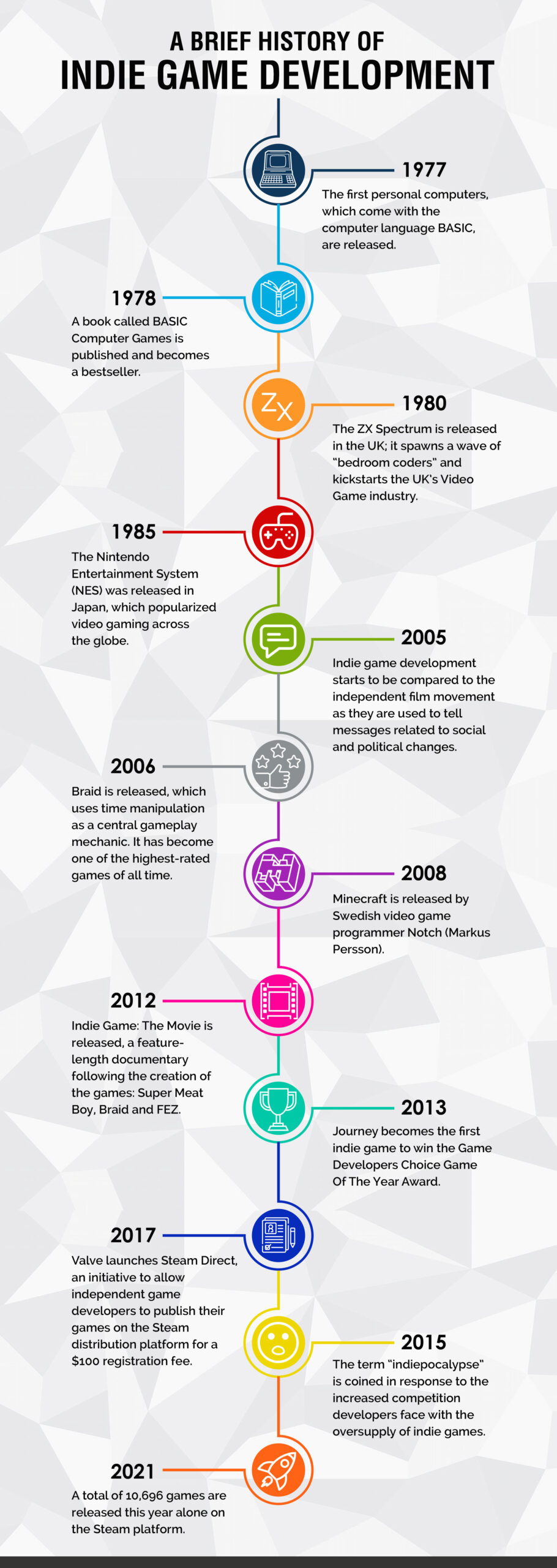
Download this infographic: low resolution, high resolution.
If our infographic has you interested in learning more, keep reading as we take a deep dive into this aspect of video gaming’s rich history.
The Dawn of Indie Game Development: Personal Computers and BASIC, 1977
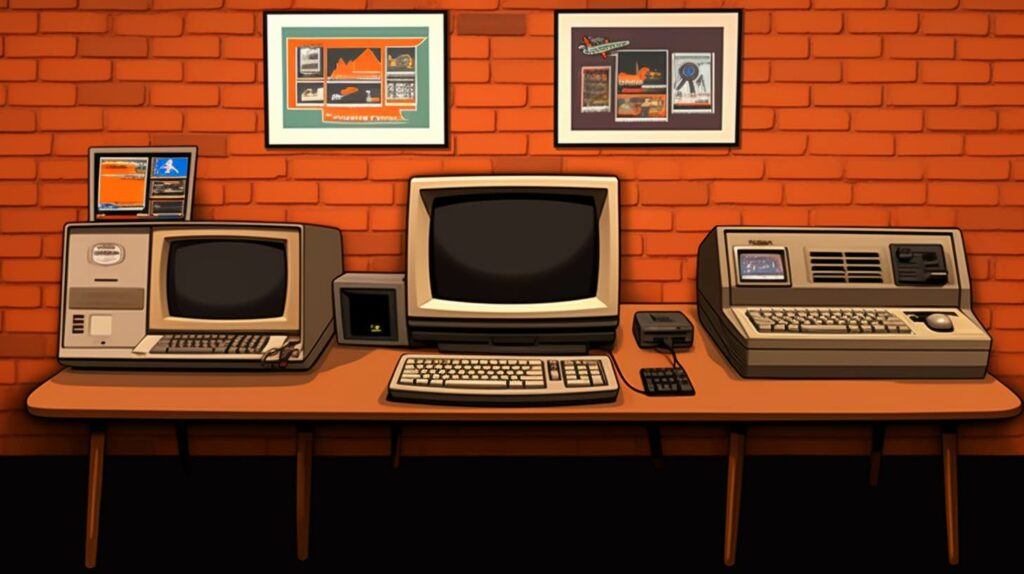
In 1977, we witness a crucial turning point in the world of gaming, marking the true genesis of indie game development. This pivotal year saw the introduction of the first personal computers, most notably, the Apple II, the TRS-80, and the Commodore PET. But what made these computers transformative for the indie game development scene wasn’t their hardware alone—it was the fact that they came bundled with the computer programming language BASIC.
BASIC, an acronym for Beginner’s All-purpose Symbolic Instruction Code, was designed to be an easy-to-learn language for beginners. The inclusion of BASIC with these personal computers meant that, for the first time, anyone with access to a computer could learn to program and start creating their own games. This was a profound democratization of game development. Before this, creating video games was a specialized skill, often limited to large corporations with substantial resources.
The widespread availability of BASIC marked the beginning of the era of the ‘bedroom coder’. A wave of hobbyists and enthusiasts began to experiment with creating their own games, a novelty at the time. In the hands of these early indie developers, BASIC would become a tool for expressing creativity, exploring new gameplay ideas, and even pushing the boundaries of what was considered possible in a game.
This moment in 1977, therefore, isn’t just about the birth of the personal computer. It’s about the birth of indie game development as we know it. It was the moment when game development shifted from being an industrial process to an individual passion, setting the stage for the vibrant and diverse indie game scene we see today. And all of this was made possible because of the widespread accessibility of personal computers and the simplicity of the BASIC programming language.
The Power of a Book: BASIC Computer Games, 1978

Fast forward to 1978, and we see the publication of a book that became instrumental in fueling the burgeoning passion for indie game development. The book in question is “BASIC Computer Games“, authored by David H. Ahl. Why is this book so crucial, you might ask?
Well, “BASIC Computer Games” was the first collection of games written in the BASIC programming language, and it quickly became a bestseller. The book comprised simple games that beginners could code on their personal computers, serving as both a guide and an inspiration to many aspiring game developers. For many, this book was their first foray into the world of game programming.
The success of “BASIC Computer Games” underscored the potential and interest in indie game development. The book’s popularity demonstrated a clear demand and enthusiasm for accessible, user-created content. This development had a profound influence on the direction of the indie gaming industry, instilling a belief in the power of individual creativity and the potential of the personal computer as a tool for game development.
The ZX Spectrum and the Rise of the ‘Bedroom Coders’, 1980

The year 1980 introduced another significant development that further propelled the indie game scene—the release of the ZX Spectrum in the UK. This 8-bit personal home computer, known for its affordability, colour graphics, and the inclusion of BASIC, became the catalyst for a new wave of “bedroom coders”.
These “bedroom coders” were essentially early indie developers who programmed games from their homes. The ZX Spectrum, due to its affordability and versatility, made game development even more accessible. It was no longer the domain of those with expensive, high-end machines.
The impact of the ZX Spectrum on the UK’s Video Game industry was monumental. It not only kick-started the industry but also led to a flourishing indie game scene. Some of the bedroom coders of the era went on to establish successful game development studios, while others created games that are today considered classics. This era, inspired by the ZX Spectrum, fortified the foundation of indie game development, emphasizing once again the value of individual passion and creativity in shaping the world of gaming.
Global Gaming Revolution: The Nintendo Entertainment System (NES), 1985

As we cross the threshold into the mid-80s, we encounter a turning point not just for indie games, but for the entire gaming industry. In 1985, the Nintendo Entertainment System (NES) was released in Japan. This console would go on to popularize video gaming across the globe, marking a new chapter in the history of gaming.
The NES was designed for easy and convenient use, bringing video gaming into the mainstream and making it a common part of household entertainment. It was also the birthplace of some of the most iconic games and franchises in history, such as Super Mario Bros. and The Legend of Zelda.
While the NES is often associated with these major franchises, it also played a crucial role in promoting indie game development. The console’s immense popularity attracted a diverse array of developers, including those outside of large development studios. This opened up a world of opportunities for indie developers, who were now able to reach a significantly wider audience with their games.
Moreover, the NES, with its intuitive game design, allowed indie developers to focus more on creativity, storytelling, and innovative gameplay mechanics, rather than complex programming. This trend of prioritizing creative design over technical prowess has since become a defining characteristic of the indie game industry.
The NES’s impact on gaming cannot be understated. It ignited a global passion for video games and helped lay the groundwork for the vibrant indie game development scene we know today. It stands as a testament to the potential of gaming as a medium for creativity and innovation.
Independent Cinema Meets Game Development, 2005

A crucial moment in indie game history arrived in 2005 when parallels were drawn between indie game development and the independent film movement. This connection brought a fresh perspective on the role of games as a platform for sharing unique stories and promoting social and political changes.
Indie film, noted for its thought-provoking themes, creativity, and departure from mainstream constraints, shares much with indie game development. Indie developers, much like indie filmmakers, are not bound by the need to cater to the largest possible audience. This freedom allows them to take creative risks, explore niche topics, and push the boundaries of what games can be.
This year was also significant as indie games started to be recognized for their capacity to reflect on societal issues and convey potent messages. We started to see games that weren’t just about racking up high scores or completing quests, but that offered deeper narratives and emotionally resonant experiences.
This shift in perception opened the door to a new era of game development. It allowed indie developers to experiment and innovate, leading to a range of games that provided unique and powerful experiences. This divergence from mainstream AAA games brought a new depth and diversity to the world of gaming and cemented the important role of indie games within the broader industry.
A Time-Bending Innovation: Braid, 2006
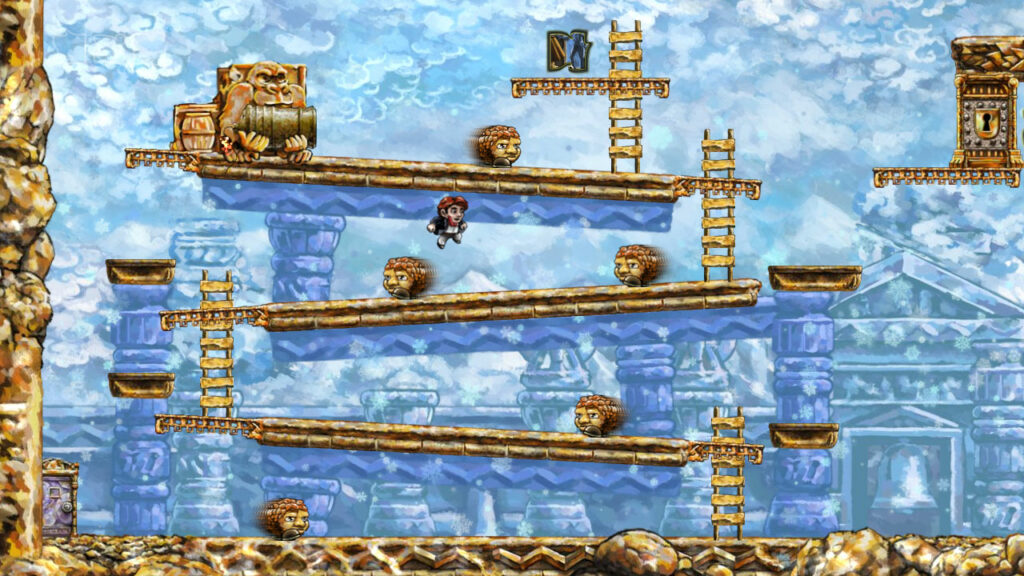
2006 was a monumental year for indie gaming. It was the year Jonathan Blow’s masterpiece, “Braid,” made its debut. It was not only a commercial success but a critical darling, earning recognition as one of the highest-rated games of all time.
“Braid” stood out for its innovative use of time manipulation as a central gameplay mechanic, turning traditional platforming on its head. This distinctive feature allowed players to rewind time, paving the way for unique puzzle-solving scenarios that challenged conventional video game logic. It offered players a fresh, thoughtful approach to gameplay, and its unique mechanics quickly caught the attention of both players and critics alike.
“Braid” is also widely celebrated for its poignant narrative and stunning hand-painted visuals. Its rich storytelling – a tale of love, loss, and regret – was layered and open to interpretation, contributing to its status as a groundbreaking example of video games as a form of art.
Jonathan Blow’s triumph with “Braid” inspired countless developers, demonstrating that innovative mechanics and deeply personal narratives could lead to success in the indie game scene. Its impact continues to resonate within the indie game community today.
An Indie Titan Emerges: Minecraft, 2008
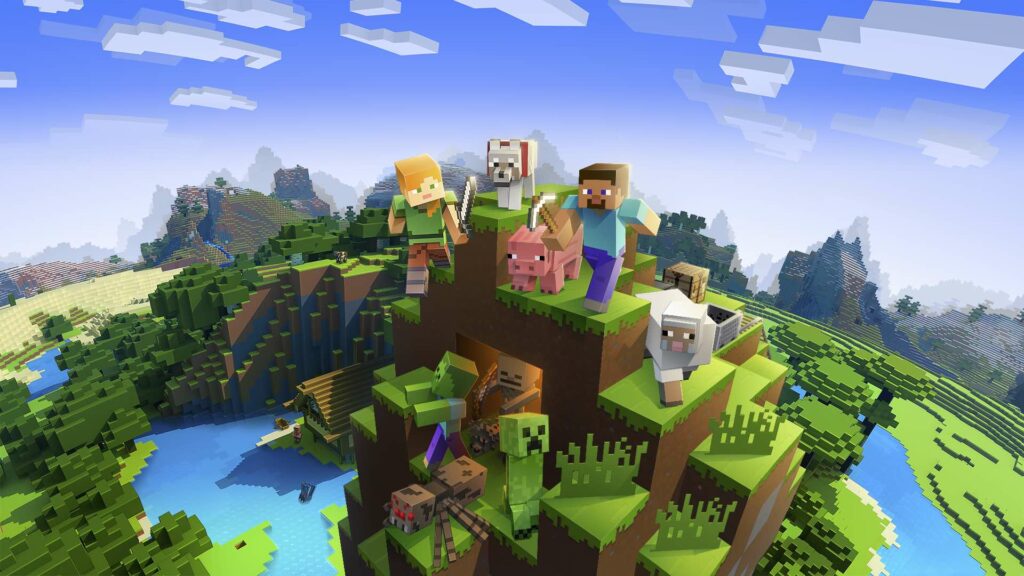
When one thinks of indie game development, it’s almost impossible not to think of the 2008 release that changed everything – Minecraft. Created by Swedish video game programmer Markus Persson, known popularly as “Notch”, Minecraft started as a humble sandbox game built in Java but rapidly grew into a cultural phenomenon.
Minecraft introduced the world to a game where the only limit was your imagination. Its unique, blocky aesthetics, open-world gameplay, and robust crafting system were unlike anything gamers had seen before. Whether you wanted to build a simple house, a complex redstone circuit, or an entire kingdom, Minecraft offered endless possibilities.
Its distinctive feature – the ability to create, shape, and interact with an open world – broke the traditional confines of game design, enabling players to become the architects of their own virtual landscapes. From elaborate castles and intricate machines to stunning recreations of famous landmarks, Minecraft allowed players to bring their most ambitious ideas to life.
Not only did Minecraft become the biggest-selling indie game of all time after its sale to Microsoft Corporation, but it also reshaped the landscape of gaming. It opened the doors for user-generated content and inspired a new generation of games that champion creativity, exploration, and player agency. Today, Minecraft is more than a game; it’s a cultural institution and a testament to the incredible potential of indie game development.
The Spotlight Turns to Indies: “Indie Game: The Movie”, 2012
In 2012, the indie game development scene gained international attention thanks to the release of a groundbreaking documentary called “Indie Game: The Movie“. This was a pivotal moment in indie game history as it brought the world of indie game creation from the shadows of the industry into the limelight.
This feature-length documentary followed the arduous and passionate journeys of indie developers as they created and released their games. The film highlighted the stories behind some of the most influential indie games of the time: Super Meat Boy, Braid, and FEZ. These games weren’t just successful commercial products; they were labor of love, driven by the developers’ passion for gaming and their vision for what games could be.
Through intimate interviews and candid behind-the-scenes footage, “Indie Game: The Movie” laid bare the trials, tribulations, and triumphs of indie game development. It showcased the immense dedication and tenacity required to bring a game from concept to release, often against considerable odds.
The release of the documentary was a milestone in the recognition and understanding of indie game development. It showed the world that indie developers were not just hobbyists tinkering in their spare time, but dedicated creators with unique stories to tell through their games. This greater visibility helped to shift perceptions, paving the way for the continued growth and success of the indie game industry.
Journey: An Indie Triumph, 2013
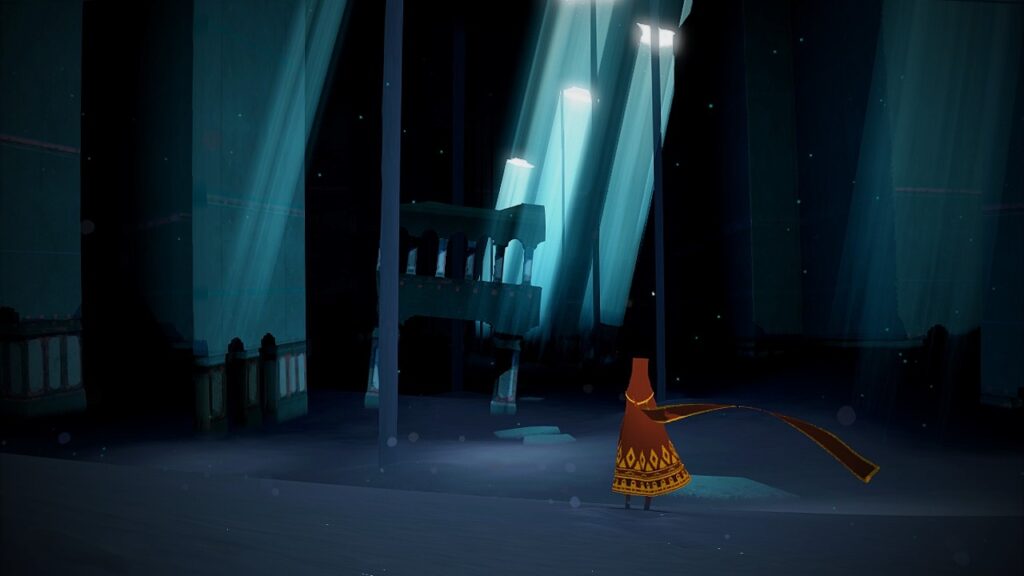
The year 2013 marked a significant milestone in the history of indie game development. For the first time ever, an indie game won the prestigious Game Developers Choice Game Of The Year Award. This game was Journey, a title that broke boundaries and established a new benchmark for what indie games could achieve.
Developed by the indie studio Thatgamecompany, Journey is an adventure game that stood out for its innovative gameplay, evocative visuals, and emotive music. Journey was not just an engaging game to play; it was a transcendent experience that captivated players and critics alike.
In the game, players control a robed figure in a vast desert, journeying towards a distant mountain. The game doesn’t guide you with explicit instructions or objectives. Instead, it lets the captivating environment and enigmatic visual cues draw you in. This minimalist yet immersive approach to storytelling was considered groundbreaking.
Winning the Game Developers Choice Game Of The Year Award was a testament to the creativity, skill, and ambition of indie developers. It signalled that indie games weren’t just side attractions in the world of gaming – they were leading innovators pushing the boundaries of what was possible in video games. This significant achievement highlighted the evolving landscape of the gaming industry, proving that with creativity and dedication, indie developers could stand toe-to-toe with the giants of the industry.
The Rise and Stabilization of Indie Games: Indiepocalypse, 2015

In 2015, the indie game development scene encountered an interesting turn of events with the advent of the so-called “indiepocalypse.” This term was coined to describe the surge in competition that indie developers faced due to an oversupply of games in the market. The proliferation of user-friendly game development tools had made it possible for anyone with a good idea and a computer to create and distribute video games, leading to an influx of new indie titles.
This sudden flood of new games led to fears that the market was oversaturated, that it was becoming increasingly difficult for developers to make their games stand out, and that the golden age of indie games was coming to an end. However, these fears eventually proved to be unfounded. Rather than signifying the end of indie games, the “indiepocalypse” marked a period of adjustment and maturation in the indie game industry.
As the market matured, developers, players, and platforms adapted to the increased competition. Developers learned to be more strategic in marketing their games and differentiating their products. Players enjoyed a wider variety of games to choose from. Platforms, on the other hand, found new ways to showcase and curate the vast number of games available.
The term “indiepocalypse” might suggest a disaster, but the reality was far from it. It was a time of evolution for the industry, a sign of the vibrancy and diversity of indie game development. It showed that the indie game scene was not a fleeting trend but a resilient and vital part of the broader gaming landscape.
A New Era of Accessibility: Valve Launches Steam Direct, 2017
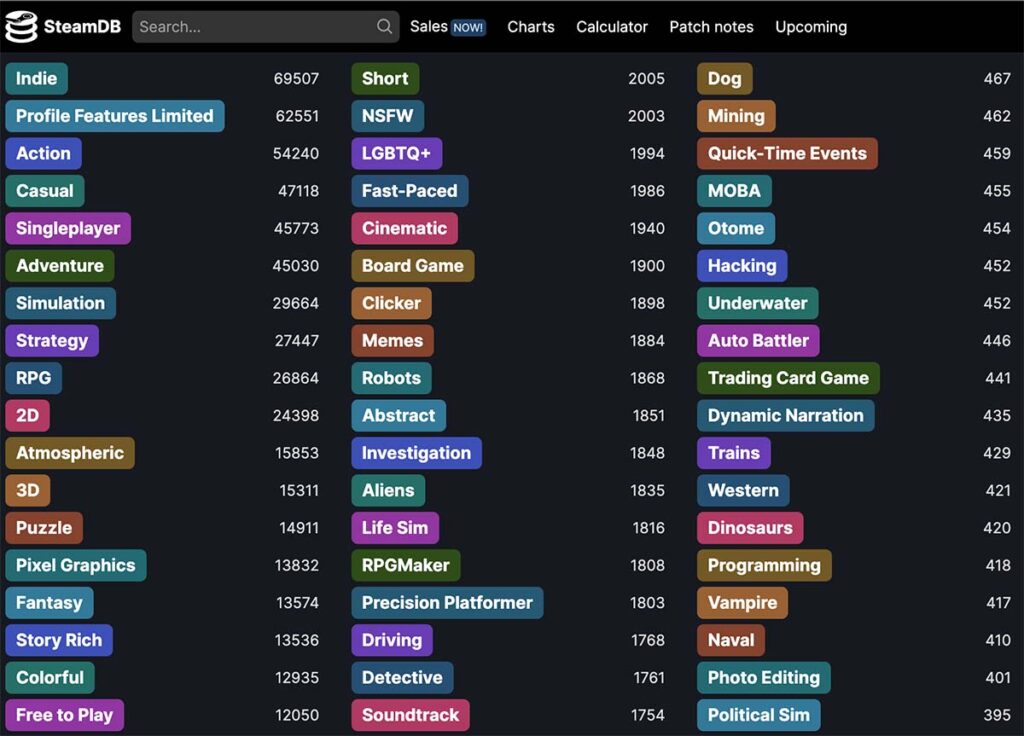
In 2017, Valve made a significant move that further shaped the indie game landscape with the launch of Steam Direct. This new initiative enabled independent game developers to self-publish their games on the Steam platform for a mere $100 registration fee, marking a huge stride in the democratization of game publishing.
Before Steam Direct, getting a game on the Steam platform required a process of selection, often seen as a barrier for many smaller developers. The introduction of Steam Direct, however, streamlined the process, allowing anyone with a game and a dream to reach out to the platform’s extensive user base.
This move had a profound impact on the indie gaming industry. It signaled to developers worldwide that indie games were not only accepted but also welcomed and encouraged on the most popular gaming platform. By removing barriers and allowing for more games to be published, it created even more opportunities for indie developers to showcase their creativity and reach a broad audience. This increased access also enhanced the diversity of the platform, offering players a wider range of unique, innovative games to choose from.
Although this made the marketplace even more competitive, it was a reaffirmation of the indie spirit: giving voice to individual creators and small teams, allowing them to share their unique visions with the world. It was a testament to the strength and vitality of indie game development and an exciting hint at the possibilities to come in the future.
The Indie Tsunami: Over 10,000 Games Released on Steam in 2021
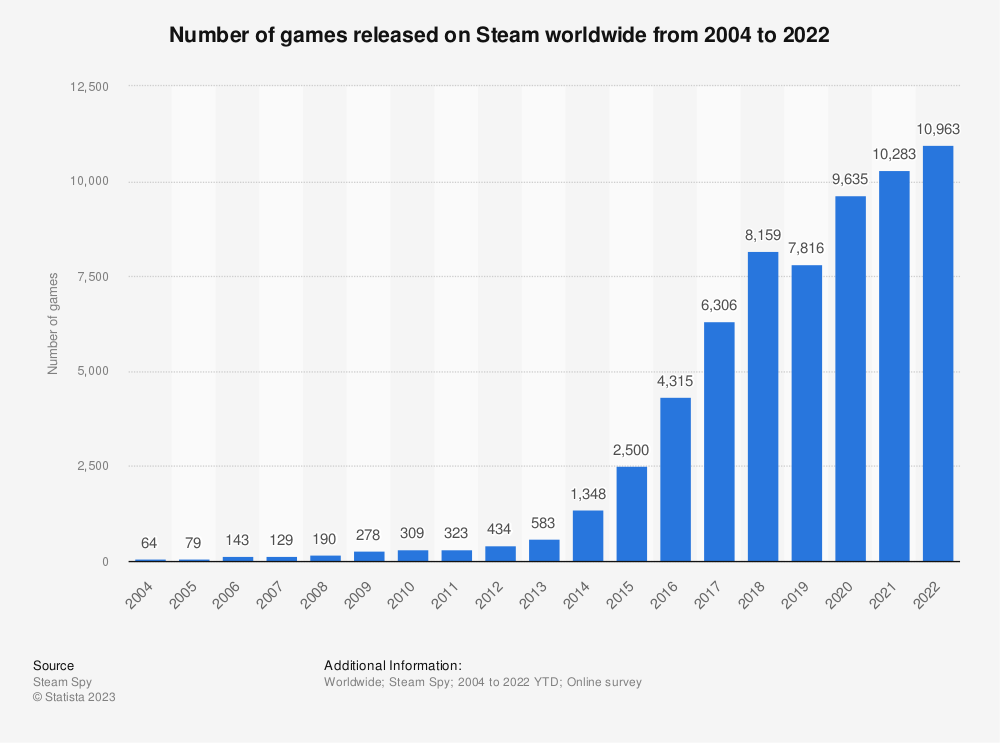
As we fast-forward to the recent past, the year 2021, we see the effects of the rapid growth and proliferation of indie games. An astonishing total of 10,696 games were released in that year alone on the Steam platform. This staggering number is a testament to the accessibility and popularity of indie game development, enabled in large part by the initiatives and platforms discussed earlier.
However, the high volume of game releases also posed challenges. With so many titles vying for attention, indie developers needed to find ways to stand out in a crowded market. They faced the paradox of choice for the consumers – the more games available, the harder it is for any one game to stand out. Marketing, uniqueness, and quality became crucial factors for success.
Yet, the massive influx of indie games wasn’t seen as a negative trend. Instead, it signaled a vibrant and thriving industry. The “indiepocalypse” fear seemed more and more misplaced. The market wasn’t crashing; it was maturing and adjusting to the increased competition. The crowded marketplace challenged developers to elevate their work, fostering creativity and innovation.
The year 2021 also made one thing clear: Indie game development was no longer just a subgenre or niche sector of the gaming industry. It had grown into a significant force that had changed the gaming landscape. It’s hard to say what the future holds, but if the trend continues, we’re likely to see even more creative, unique, and exciting indie games in the years to come.
Final Thoughts: The Future of Indie Game Development

Reflecting on the rich history of indie game development, it’s clear that this creative sector has come a long way since the days of ‘bedroom coders.’ This journey through time has seen humble beginnings, landmark breakthroughs, and a dramatic rise in volume and quality.
In a short span of a few decades, indie games have transformed from a hobbyist pastime to a significant player in the global gaming industry. But more than just the numbers, indie games represent the spirit of innovation, pushing boundaries, and challenging conventions. They offer a space for creative freedom, allowing developers to explore unique themes, narratives, and gameplay mechanics that might not find a place in AAA games.
But, with this success comes new challenges. As we’ve seen in 2021, the surge in the number of indie games creates a crowded marketplace. It’s crucial for indie developers to continue innovating and finding ways to stand out. As such, indie game development is as much about creativity in design as it is about creativity in marketing and engagement.
Looking ahead, the future of indie game development seems bright. The advent of new technologies, the growing support for indie developers, and the increasing recognition of indie games’ cultural and artistic value all suggest that the best days of indie games may well be ahead of us.
This journey through the history of indie games is not just a look into the past; it’s a lens into the future. It offers insights and lessons for aspiring game developers and enthusiasts alike. So, keep creating, keep playing, and keep pushing the boundaries. Who knows? The next major milestone in indie game development history could be just around the corner.
